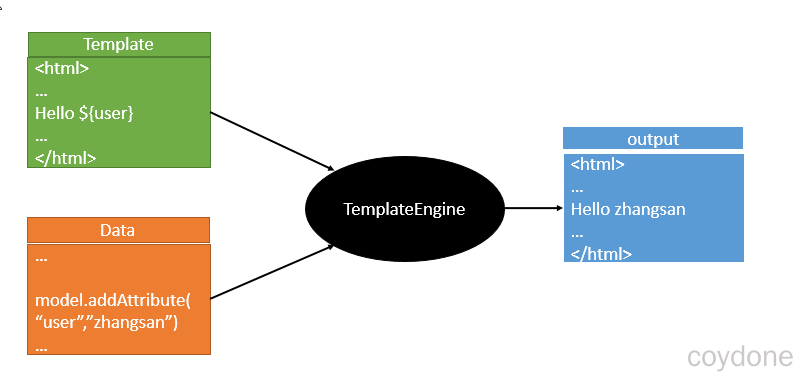视图解析:SpringBoot默认不支持 JSP,需要引入第三方模板引擎技术实现页面渲染。
视图解析的处理方式有:转发、重定向、自定义视图。
视图解析原理流程
1、目标方法处理的过程中,所有数据都会被放在 ModelAndViewContainer 里面。包括数据和视图地址。
2、方法的参数是一个自定义类型对象(从请求参数中确定的),把他重新放在 ModelAndViewContainer。
3、任何目标方法执行完成以后都会返回 ModelAndView(数据和视图地址)。
4、processDispatchResult 处理派发结果(页面该如何响应)
-
1、render(mv, request, response); 进行页面渲染逻辑。
-
1、根据方法的String返回值得到 View 对象【定义了页面的渲染逻辑】。
-
1、所有的视图解析器尝试是否能根据当前返回值得到View对象。
-
2、得到了 redirect:/main.html → Thymeleaf new RedirectView()。
-
3、ContentNegotiationViewResolver 里面包含了下面所有的视图解析器,内部还是利用下面所有视图解析器得到视图对象。
-
4、view.render(mv.getModelInternal(), request, response); 视图对象调用自定义的render进行页面渲染工作
-
RedirectView 如何渲染【重定向到一个页面】
-
1、获取目标url地址
-
2、response.sendRedirect(encodedURL);
-
-
-
视图解析:
-
返回值以 forward: 开始:
new InternalResourceView(forwardUrl);→ 转发request.getRequestDispatcher(path).forward(request, response); -
返回值以 redirect: 开始:
new RedirectView()→ redirect就是重定向 -
返回值是普通字符串:
new ThymeleafView()
Thymeleaf
引入
前端交给我们的页面,是HTML页面。如果是我们以前开发,我们需要把他们转成JSP页面,JSP好处就是当我们查出一些数据转发到JSP页面以后,我们可以用JSP轻松实现数据的显示,及交互等。
JSP支持非常强大的功能,包括能写Java代码,但是SpringBoot项目是以jar的方式,不是war,我们用的还是嵌入式的Tomcat,所以默认是不支持JSP的。
那不支持JSP,如果我们直接用纯静态页面的方式,那给我们开发会带来非常大的麻烦,于是SpringBoot推荐你可以来使用模板引擎。
模板引擎,我们其实大家听到很多,其实JSP就是一个模板引擎,还有用的比较多的freemarker,Velocity,包括SpringBoot给我们推荐的Thymeleaf,模板引擎有非常多,但再多的模板引擎,他们的思想都是一样的。

模板引擎的作用就是我们来写一个页面模板,比如有些值呢,是动态的,我们写一些表达式。而这些值,从哪来呢?就是我们在后台封装一些数据。然后把这个模板和这个数据交给我们模板引擎,模板引擎按照我们这个数据帮你把这表达式解析、填充到我们指定的位置,然后把这个数据最终生成一个我们想要的内容给我们写出去,这就是我们这个模板引擎,不管是JSP还是其他模板引擎,都是这个思想。只不过不同模板引擎之间,他们可能这个语法有点不一样。
SpringBoot推荐的Thymeleaf模板引擎,它的语法更简单、功能更强大。
Thymeleaf介绍
Thymeleaf是一款用于渲染XML/XHTML/HTML5内容的模板引擎。类似JSP,Velocity,FreeMaker等,它也可以轻易的与Spring MVC等Web框架进行集成作为Web应用的模板引擎。与其它模板引擎相比,Thymeleaf最大的特点是能够直接在浏览器中打开并正确显示模板页面,而不需要启动整个Web应用。Spring Boot推荐使用Thymeleaf、Freemarker等后现代的模板引擎技术;一但导入相关依赖,会自动配置ThymeleafAutoConfiguration、FreeMarkerAutoConfiguration。
引入Thymeleaf
在pom文件中引入thymeleaf启动器
<properties>
<thymeleaf.version>3.0.2.RELEASE</thymeleaf.version>
<!-- 布局功能的支持程序 thymeleaf3主程序 layout2以上版本 -->
<!-- thymeleaf2 layout1 -->
<thymeleaf-layout-dialect.version>2.1.1</thymeleaf-layout-dialect.version>
</properties>
<dependencys>
<!--引入thymeleaf模块-->
<dependency>
<groupId>org.springframework.boot</groupId>
<artifactId>spring-boot-starter-thymeleaf</artifactId>
</dependency>
</dependencys>
-
Thymeleaf 官网:https://www.thymeleaf.org/。
-
Thymeleaf 在Github 的主页:https://github.com/thymeleaf/thymeleaf。
Thymeleaf的使用
只要我们把HTML页面放在classpath:/templates/,thymeleaf就能自动渲染。
@ConfigurationProperties(
prefix = "spring.thymeleaf"
)
public class ThymeleafProperties {
private static final Charset DEFAULT_ENCODING;
public static final String DEFAULT_PREFIX = "classpath:/templates/";//默认前缀
public static final String DEFAULT_SUFFIX = ".html";//默认后缀
private boolean checkTemplate = true;
private boolean checkTemplateLocation = true;
private String prefix = "classpath:/templates/";//前缀
private String suffix = ".html";//后缀
private String mode = "HTML";
//......
}
测试
在java包下新建controller包写一个Controller。
package com.coydone.controller;
@Controller
public class HelloController {
@RequestMapping("/success")
public String success(){
//classpath:/templates/success.html
return "success";
}
}
在rescources/templates下写一个success.html页面。
在浏览器中输入localhost:8080/success即可访问success.html页面。
在页面中展示数据
1、编写controller类
//查出一些数据,在页面展示
@RequestMapping("/success")
public String success(Map<String,Object> map){
map.put("hello","你好");
return "success";
}
2、导入thymeleaf的名称空间(会有提示功能)
<html lang="en" xmlns:th="http://www.thymeleaf.org">
3、使用thymeleaf语法写success.html页面,浏览器访问localhost:8080/success。
<!DOCTYPE html>
<html lang="en" xmlns:th="http://www.thymeleaf.org">
<head>
<meta charset="UTF-8">
<title>Title</title>
</head>
<body>
<h1>成功!</h1>
<!--th:text 将div里面的文本内容设置为 -->
<div th:text="${hello}">这是显示欢迎信息</div>
</body>
</html>
基本语法
1、th:text,改变当前元素里面的文本内容;th:任意html属性;来替换原生属性的值。

2、表达式
Simple expressions:(表达式语法)
Variable Expressions: ${...}:获取变量值;OGNL;
1)、获取对象的属性、调用方法
2)、使用内置的基本对象:
#ctx : context对象
#vars:context变量
#locale : 国际化对象
#request : (only in Web Contexts)HttpServletRequest对象
#response : (only in Web Contexts)HttpServletResponse对象
#session : (only in Web Contexts)HttpSession对象
#servletContext : (only in Web Contexts)ServletContext对象
${session.foo}
3)、内置的一些工具对象:
#execInfo : 正在处理的模板信息
#messages : 在变量表达式中获取外部消息的方法,与使用#{…}语法获得这些消息的方法相同。
#uris : 转义部分URLs/URIs的方法
#conversions : 执行配置的转换服务(如果有)的方法。
#dates : java.util.Date对象方法:格式化、组件提取等。
#calendars :类似于#dates , 但是是java.util.Calendar对象
#numbers : 格式化数字对象的方法
#strings:字符串对象方法:contains、startsWith、prepending/appending等。
#objects : 对象的一般方法
#bools : 布尔求值方法。
#arrays : array方法
#lists : list方法
#sets : set集合方法
#maps : map集合方法
#aggregates : 在数组或集合上创建聚合的方法。
#ids : 处理可能重复的id属性的方法(例如,作为迭代的结果)。
Selection Variable Expressions: *{...}:选择表达式:和${}在功能上是一样;
补充:配合 th:object="${session.user}:
<div th:object="${session.user}">
<p>Name: <span th:text="*{firstName}">Sebastian</span>.</p>
<p>Surname: <span th:text="*{lastName}">Pepper</span>.</p>
<p>Nationality: <span th:text="*{nationality}">Saturn</span>.</p>
</div>
Message Expressions: #{...}:获取国际化内容
Link URL Expressions: @{...}:定义URL;
@{/order/process(execId=${execId},execType='FAST')}
Fragment Expressions: ~{...}:片段引用表达式
<div th:insert="~{commons :: main}">...</div>
Literals(字面量)
Text literals: 'one text' , 'Another one!' ,…
Number literals: 0 , 34 , 3.0 , 12.3 ,…
Boolean literals: true , false
Null literal: null
Literal tokens: one , sometext , main ,…
Text operations:(文本操作)
String concatenation: +
Literal substitutions: |The name is ${name}|
Arithmetic operations:(数学运算)
Binary operators: + , - , * , / , %
Minus sign (unary operator): -
Boolean operations:(布尔运算)
Binary operators: and , or
Boolean negation (unary operator): ! , not
Comparisons and equality:(比较运算)
Comparators: > , < , >= , <= ( gt , lt , ge , le )
Equality operators: == , != ( eq , ne )
Conditional operators:条件运算(三元运算符)
If-then: (if) ? (then)
If-then-else: (if) ? (then) : (else)
Default: (value) ?: (defaultvalue)
Special tokens:特殊操作
No-Operation: _
语法测试:
controller/HelloController.java
//查出一些数据,在页面展示
@RequestMapping("/success")
public String success(Map<String,Object> map){
map.put("hello","<h1>你好</h1>");
map.put("users", Arrays.asList("张三","李四","王五"));
return "success";
}
rescources/templates/success.html
<!DOCTYPE html>
<html lang="en" xmlns:th="http://www.thymeleaf.org">
<head>
<meta charset="UTF-8">
<title>Title</title>
</head>
<body>
<h1>success,这是成功页面</h1>
<div id="div01" th:text="${hello}" th:id="${hello}"></div>
<hr />
<div th:text="${hello}"></div>
<div th:utext="${hello}"></div>
<hr />
<!--th:each每次遍历都会生成当前这个标签:3个h2-->
<h2 th:text="${user}" th:each="user:${users}"></h2>
<hr />
<div>
<!-- 行内写法 [[]] 表示th:text [()] 表示th:utext -->
<h3 th:each="user:${users}">[[${user}]]</h3>
</div>
</body>
</html>
运行结果:






评论区